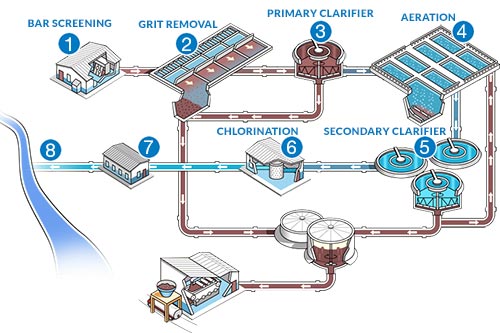Comprehending Wastewater Therapy Processes and Their Environmental Impact
The complexities of wastewater therapy processes play a crucial duty in mitigating environmental challenges connected with water pollution. Each phase, from initial to advanced therapies, is designed to address details contaminants, ultimately guarding both public health and aquatic ecological communities.
Summary of Wastewater Treatment
How is wastewater transformed into a safe source for the environment? Wastewater therapy is a critical procedure designed to get rid of pollutants from made use of water, thus protecting public health and wellness and shielding environments. This process starts with the collection of wastewater from residential, commercial, and industrial resources, which is after that directed to treatment centers.
At these centers, different physical, chemical, and organic methods are employed to deal with the wastewater. Subsequently, biological treatments, such as triggered sludge procedures, use microorganisms to break down natural issue.
The treated effluent can be safely discharged into natural water bodies or reused for watering and industrial objectives, promoting source preservation. Additionally, the therapy procedure generates biosolids, which can be repurposed as fertilizers or soil modifications, even more improving sustainability.
Phases of Therapy Processes
The wastewater treatment procedure normally is composed of 3 primary stages: preliminary, key, and secondary treatment. Each phase offers a distinct duty in lowering the pollutant load and guaranteeing the effluent meets environmental criteria prior to discharge.

The main treatment stage concentrates on the physical splitting up of put on hold solids from the wastewater. Through sedimentation, much heavier particles resolve at the bottom of sedimentation tanks, forming sludge, while lighter materials, such as oils and greases, float to the surface area and are skimmed off. This procedure substantially minimizes the organic and not natural load in the wastewater.
Second treatment is an organic process intended at further reducing the concentration of natural issue. This stage is vital for accomplishing the necessary biochemical oxygen need (BOD) decrease, inevitably leading to cleaner effluent ready for discharge or more therapy.

Advanced Treatment Technologies
Following the second treatment procedures, advanced therapy modern technologies play an important function in additional improving the high quality of dealt with wastewater. These technologies are designed to remove recurring contaminants that are not properly eliminated throughout primary and secondary therapies, making certain the effluent fulfills strict governing standards.
Amongst the extensively made use of sophisticated treatment methods are membrane filtration, reverse osmosis, and progressed oxidation processes. Membrane layer filtration, including microfiltration and ultrafiltration, works in separating fine particles, virus, and colloids from the water (Wastewater). Reverse osmosis uses semi-permeable membranes to eliminate liquified solids, resulting in premium water suitable for numerous applications
Advanced oxidation processes (AOPs) employ solid oxidants to break down organic pollutants, consisting of pharmaceuticals and personal care products that are resistant to conventional treatment. These approaches boost the biodegradability of intricate substances, this website promoting their removal.
Another significant modern technology is the usage of biological nutrient removal processes, which specifically target nitrogen and phosphorus, preventing eutrophication in obtaining water bodies. Generally, advanced treatment modern technologies are vital for attaining higher levels of filtration, promoting water reuse, and safeguarding public health and wellness while dealing with the challenges linked with wastewater administration.
Ecological Benefits of Treatment
Many ecological benefits emerge from effective wastewater therapy procedures that add to ecosystem health and wellness and sustainability. Largely, these procedures substantially minimize the launch of dangerous pollutants right into all-natural water bodies, which assists keep aquatic environments. By removing contaminants such as hefty steels, nutrients, and pathogens, dealt with wastewater reduces the danger of waterborne illness and advertises biodiversity in marine settings.
In addition, wastewater therapy centers usually use innovative modern technologies that allow water recycling and reuse. This method not just preserves fresh water sources yet also minimizes the demand on all-natural water supplies. Boosted nutrient elimination from wastewater can additionally prevent eutrophication, a process that brings about algal flowers and subsequent oxygen depletion in marine systems.
Furthermore, effective therapy processes can lessen greenhouse gas discharges, especially methane and nitrous oxide, which are frequently released throughout untreated wastewater decomposition. By recording and utilizing biogas from anaerobic digesters, facilities can transform waste right into renewable energy, therefore adding to a decrease in nonrenewable fuel source reliance.
Obstacles and Future Fads
While the ecological benefits of wastewater treatment are clear, several obstacles persist that hinder optimal outcomes in this area. One major concern is aging facilities, which commonly brings about ineffectiveness and enhanced operational prices - Wastewater. Many therapy plants were developed years ago, and their capacities do not align with contemporary needs, which consist of stricter governing standards and higher volumes of wastewater because of urbanization

Looking in advance, there is an expanding focus on straight from the source source recuperation and round economy concepts within wastewater therapy. Developments such as anaerobic food digestion, which can generate biogas, and progressed filtration technologies are acquiring traction. These approaches not only enhance treatment performance yet additionally advertise sustainability.
Eventually, dealing with these challenges needs cooperation amongst stakeholders, investment in technology, and a dedication to recurring research. By welcoming these trends, the wastewater treatment sector can progress to fulfill the demands of a transforming atmosphere and society.
Verdict
Finally, wastewater therapy processes More Info play an essential function in enhancing environmental quality and public health. The multi-stage treatment structure, combined with advanced technologies, successfully reduces air pollution and advertises lasting water management. By dealing with recurring contaminants and reducing nutrition overflow, these processes add to the preservation of aquatic environments and the decrease of greenhouse gas emissions. Continued improvements and adjustments in treatment approaches will certainly be crucial for conquering emerging challenges and guaranteeing the sustainability of natural resources (Wastewater).